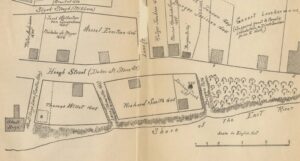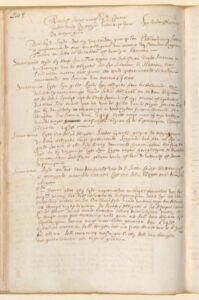
Map of the East River shore in 1655, Meyer’s house just north of Stadt Huys, J.H. Innes, 1902, New Amsterdam and Its People
Nicolaes De Meyer (Nicholas/Nicolaus/Nicol de Myer/Mayer/Mayor), Mayor 1676-1677: De Meyer (1635 –1691) was a merchant who participated in the fur trade. He also imported consumer goods and French wine from his contacts in Amsterdam.[1]
His direct involvement in slavery:
- The history book Root & Branch states that during the Dutch colonial period, “Nicholas de Mayer, Govert Loockermans, and Jacob Leisler obtained slaves to use in mills at the Fresh Water Pond adjacent to the ‘negro land.’”[2]
- He purchased “1 negro” for 460 florins on May 29, 1664.[3]
- In an April 21, 1675, Mayor’s Court case, Emanuell Mandeville sued “Nicol De Mayor” for detaining “a negro belonging to Major Kingsland.”[4] The enslaved man, named Arro or Arrow, was determined to be the property of Major Kingsland and De Meyer was ordered to deliver him along with court costs to Mandeville. De Meyer then appealed the case to the Court of Assizes, but that court also found that Arrow belonged to Major Kingston and De Meyer had to pay court costs.[5]
- On April 30, 1680, Albany probate records state that Nicolaus De Meyer or Myer received satisfaction from Alexander Glen for a mortgage on “house, lot, lands, and slaves.”[6]
- On March 7, 1683, the Court of Wiltwyck (later Ulster County) awarded De Meyer 500 schepels of wheat and two enslaved persons after a previous jury trial:
Roelof Swartwout Complt v.s. Wilhelmus DeMeyer, attorney for this father Nicolaes DeMeyer, Deft. Complt says that last year at an extraordinary session he has been ordered to immediately pay an obligation of about five hundred sch. of wheat, or immediate execution. Swartwout says that he has been obliged to his damage and ruin and sorrow to surrender two negroes for the sake of satisfying the sentence and paying the obligation for the purpose of preventing execution, amounting to four thousand eight hundred gldrs…Complaint is obliged to pay an obligation of 500 schepels of wheat; also to surrender two negroes.[7]

Swartwout v. De Meyer Court case (in Dutch), Ulster County Archives, NY Heritage
[1] Merchants & Empire, p.94; “Commerce and Community,” p.110
[2] Root & Branch, p.31; The iconography of Manhattan Island, 1498-1909…, Volume 2 p.308
[3] Documents Illustrative of the Slave Trade, Donnan, ed., p.428
[4] Minutes of the Mayor’s Court of New York, 16741-1675, ed. Kenneth Scott, p.37
[5] Records of the Court of Assizes for the colony of New York, 1665-1682, eds.Peter R. Christoph and Florence A. Christoph, p.157 and 180
[6] Index to the Public Records of the County of Albany, 1630-1894, Vol. V, FamilySearch, viewer p.83
[7] Ulster County Archives, Dutch court records of Wiltwyck 1661-1709, Ulster County Archives, Dutch Court Records Volume 6, p.243-244, English translation of case
Copyright 2025 Paul Hortenstine



